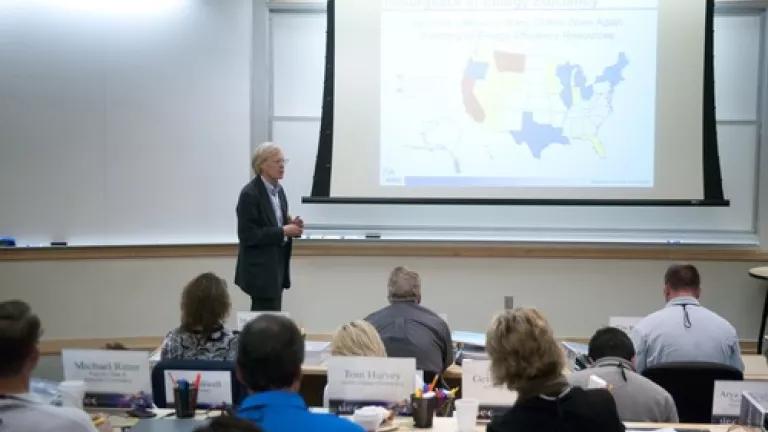
It’s not often that an environmental advocate gets to share good news about energy with electricity industry executives.
But I recently had the opportunity to do so during the annual summer course on energy issues that I teach at the University of Idaho.
Each summer for almost 60 years, the university has brought about 50 emerging electricity industry leaders to its campus in Moscow for mid-career reflection and training by the faculty of the University of Idaho Utility Executive Course, which has counted me among its number for the last two decades.
This year, I prepared a set of what I called “Leading Energy Indicators” that tracked trends over the past 10 to 40 years and even the most experienced and savvy members of my audience were surprised to learn that:
1. Although the U.S. economy has almost tripled in size over the past forty years, oil use is up by only about one percent. Just since 2005, we’ve cut oil consumption by over 12 percent; that year will almost certainly rank as the all-time peak, given prospects for sustained progress in fuel economy and the continuing emergence of other alternatives to oil. Those who complain that the United States has made no progress in reducing its oil dependence are entirely wrong.
2. Looking ahead, higher fuel economy standards already adopted for cars and light trucks will be saving the equivalent of more than two million barrels of oil a day by 2025 -- that’s more than one-tenth of total U.S. oil use today, comparable to what we import from Saudi Arabia and Venezuela combined.
3. Since 2000, U.S. electricity use has grown more slowly than the population for the first sustained period since the industry was launched a century ago by Thomas Edison and Samuel Insull, who helped create the nation’s electrical infrastructure. In just the past decade, our use of coal to generate electricity has declined significantly – by the annual equivalent of more than sixty giant 500 Megawatt power plants, which represents about ten percent of total U.S. coal-fired generation capacity. The principal replacement sources have been natural gas and wind power (the latter of which boosted its production 20-fold in just a decade), yielding a giant national and international dividend in avoided emissions of sulfur dioxide, nitrogen oxides, mercury and carbon dioxide.
4. When you adjust for economic growth and inflation, the United States has cut its energy needs by more than 50% since 1973 and the trend shows no signs of slowing. If you treat this 40-year reduction as the equivalent of new energy supply, the resulting resource is now almost four times larger than the expansion of output from all other energy sources combined over that same period (including oil, natural gas, nuclear power, biofuels, wind and solar).
In other words, without those continuing reductions in the economy’s energy intensity, we would have needed to increase contributions from all other fuels combined by about fourfold. Since 1973, the total growth in U.S. energy needs has been less than 30 percent.
While we can and must do better, this is progress beyond the wildest dreams of most who tried to predict energy supply and demand trends in the 1970s (save for a few visionaries like Amory Lovins, Art Rosenfeld and NRDC’s David Goldstein).
Any temptation to credit market forces solely for these positive energy trends is rebutted by a glance at the record: Oil and natural gas prices have fluctuated wildly over the past four decades, and electricity costs show no clear trend (the average kilowatt-hour costs about the same today, adjusted for inflation, as it did in 1990).
What clearly has worked to reduce energy needs is the effective coordination of incentives and efficiency standards; for example, utilities acting in coordination with regulators have driven the electricity consumption of the average refrigerator more than 70 percent lower since the mid-1970s. Federal efficiency standards adopted in the past year will soon cut electricity and water needs for clothes- and dish-washing by more than half since the mid-1990s. By 2025, passenger vehicles will average two and a half times the miles per gallon of their mid-1970s counterparts.
We did all this with energy policy developed quietly at both state and federal levels, at a time when a favorite bipartisan ritual in Washington, D.C., is to bemoan the lack of a national energy policy. This revelation may have been the most surprising one of all to the group of utility leaders sitting in that University of Idaho classroom just weeks ago.
They and their industry will of course have much to say about what happens next.
